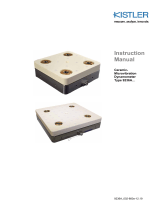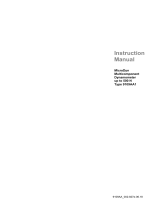Page is loading ...

Hand Dynamometer
(Order Code HD-BTA)
The Hand Dynamometer can be used to measure grip
strength or pinch strength and to perform muscle fatigue
studies. Using the appropriate data-collection hardware and
software, you can graph, record, calculate, and compare
hand grip muscle fatigue rates. This sensor can be used
alone or in combination with other sensors (e.g., EKG Sensor) for studies of
muscular health and activity.
Note: Vernier products are designed for educational use. Our products are not
designed nor are they recommended for any industrial, medical, or commercial
process such as life support, patient diagnosis, control of a manufacturing
process, or industrial testing of any kind.
What's Included
Hand Dynamometer
Compatible Software and Interfaces
See www.vernier.com /manuals/hd-bta for a list of interfaces and software compatible
with the Hand Dynamometer.
Getting Started
1. Connect the sensor to the interface (LabQuest Mini, LabQuest 2, etc.).
2. Start the appropriate data-collection software (Logger Pro, Logger Lite,
LabQuest App) if not already running, and choose New from File menu.
The software will identify the sensor and load a default data-collection setup. You
are now ready to continue your experiment.
If you are collecting data using a Chromebook™, mobile device such as iPad
®
or
Android™ tablet, or a Vernier wireless sensor or interface, please see the following
link for up-to-date connection information:
www.vernier.com/start/hd-bta
U sing the Product
Connect the sensor following the steps in the Getting Started section of this user
manual.
The Hand Dynamometer can be used to measure grip strength or pinch strength.
Grip strength is assessed holding the sensor in a vertical position with the arm
perpendicular to the body and fingers on the pad distal to the longer proximal
portion to which the palm is pressed. Strength can be measured by applying
pressure for a series of short grasps or over a sustained duration.
Pinch strength is assessed by placing the sensor on a flat horizontal surface with
the pinch sensor pads in a vertical alignment, extending beyond the table plane.
Using your thumb and forefinger, place each on the respective opposing pinch
pads and press.
Potential Uses for this Sensor
The following is a list of activities and experiments that can be performed using
this sensor.
Determine if grip and pinch strength are a function of age.
Compare hand grip strength with pinch strength. Devise and carry out a study
to explore if there is a correlation between them.
Measure muscle fatigue by exerting maximum grip strength and sustained
grasp for as long as possible. Determine if muscle fatiguing time is similar for
all participants and if there is variation between age groupings and gender.
Predict the results of repeated trials for each member of the group.
Measure the effect of squeezing a tennis ball repeatedly on grip strength.
Squeeze the ball tightly each evening fifty times for a month. At the beginning
of the month, measure and record your basal grip strength; at the end of the
month, record your hand grip strength and analyze how these values compare.
Determine if there is a correlation between hand size and grip strength.
Consider factors such as wrist and forearm circumference in relation to grip
strength and which muscle complexes are involved in grip strength and pinch
strength.
Measure hand grip strength for dominant and non-dominant hands by gripping
the dynamometer in a neutral non-supportive posture with the sensor in your
non-dominant hand. Initiate data collection while holding the sensor with a
neutral grip with eyes closed. Explore what accounts for the similarities and
differences.
2

Muscle fatigue
Fatigue over time
Videos
View videos related to this product at www.vernier.com /hd-bta
Calibration
You should not have to perform a new calibration when using the Hand
Dynamometer. We have set the sensor to match our stored calibration before
shipping it. You can simply use the appropriate calibration value that is stored in
the data-collection program.
3
Specifications
Stored calibration (N) slope: 175.416
intercept: –19.295
Stored calibration (kg) slope: 17.8875
intercept: –1.9676
Stored calibration (lbs) slope: 39.4351
intercept: –4.3379
Accuracy ±0.6 N
12-bit resolution 0.2141 N
Power 7 mA @ 5VDC
Safety range (maximum force without damage to
the sensor)
0to850N
Operational range: 0to600N
H ow t he Sensor Works
The Hand Dynamometer is a strain-gauge based isometric force sensor. This sensor
amplifies the force applied converting it into a voltage that is monitored by the
lab interface and read in the desired units of force. The Hand Dynamometer reports
values in newtons (N), pounds (lb), or kilograms (kg).
Troubleshooting
If the sensor does not read zero in the orientation in which you are using it,
follow the standard zeroing procedure for the data-collection program you are
using.
If the default experiment length is too long for your experiment, set the
data-collection parameters in the program you are using.
For additional troubleshooting and FAQs, see
www.vernier.com/til/1431
Repair Information
If you have watched the related product video(s), followed the troubleshooting
steps, and are still having trouble with your Hand Dynamometer, contact Vernier
Technical Support at support@vernier.com or call 888-837-6437. Support
specialists will work with you to determine if the unit needs to be sent in for
repair. At that time, a Return Merchandise Authorization (RMA) number will be
issued and instructions will be communicated on how to return the unit for repair.
Warranty
Vernier warrants this product to be free from defects in materials and workmanship
for a period of five years from the date of shipment to the customer. This warranty
does not cover damage to the product caused by abuse or improper use. This
warranty covers educational institutions only.
4

Vernier Software & Technology
13979 SW Millikan Way • Beaverton, OR 97005-2886
T oll F ree (888) 837-6437 • (503) 277-2299 • Fax (503) 277-2440
info@vernier.com • www.vernier .com
Rev. 3/23/16
Logger Pro, Logger Lite, Vernier LabQuest 2, LabQuest Mini, and other marks shown are our trademarks or
registered trademarks in the United States.
All other marks not owned by us that appear herein are the property of their respective owners, who may or may
not be affiliated with, connected to, or sponsored by us.
5
/







